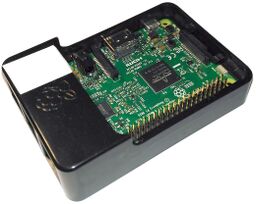NixOS on ARM/Raspberry Pi
Status
Only the Raspberry Pi 3 is supported upstream, with the aarch64 effort.
Other Raspberry Pis are part of @dezgeg's porting efforts to ARMv6 and ARMv7.
Board-specific installation notes
First follow the generic installation steps to get the installer image and install using the installation and configuration steps.
Raspberry Pi (1)
The ARMv6 image boots out-of-the-box.
Raspberry Pi 2
The ARMv7 image should boot out-of-the-box, though the author hasn't personally tested this.
Raspberry Pi 3
Both the AArch64 and ARMv7 images boot out-of-the-box. Using the 64-bit AArch64 image is highly recommended, as the availability of binaries is much better and allows the use of the 64-bit instruction set.
Use the following GPIO Pins with an USB-TTL connector:
GND - 3rd in top row, black cable
GPIO 14 TXD - 4th in top row, white cable
GPIO 15 RXD - 5th in top row, green cableUse nix-shell -p screen --run "screen /dev/ttyUSB0 115200" to connect to the console.
{
...
hardware.enableRedistributableFirmware = true;
hardware.firmware = [
(pkgs.stdenv.mkDerivation {
name = "broadcom-rpi3-extra";
src = pkgs.fetchurl {
url = "https://raw.githubusercontent.com/RPi-Distro/firmware-nonfree/54bab3d/brcm80211/brcm/brcmfmac43430-sdio.txt";
sha256 = "19bmdd7w0xzybfassn7x4rb30l70vynnw3c80nlapna2k57xwbw7";
};
phases = [ "installPhase" ];
installPhase = ''
mkdir -p $out/lib/firmware/brcm
cp $src $out/lib/firmware/brcm/brcmfmac43430-sdio.txt
'';
})
];
networking.wireless.enable = true;
}
Serial console
Your configuration.nix will need to add console=ttyS0,115200n8 to the boot.kernelParams configuration to use the serial console.
{ config, pkgs, lib, ... }:
{
boot.kernelParams = [
"console=ttyS0,115200n8"
];
}
Notes about the boot process
Raspberry Pi (all versions)
USB keyboards and HDMI displays work perfectly.
Using the 3.3v serial port via the pin headers (exact location depends on hardware version) will get u-boot output and, when configured, a Linux kernel console.
